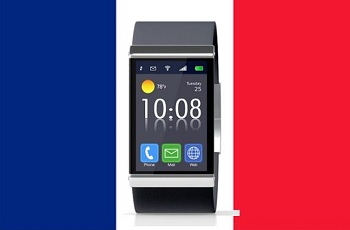Denny |
December 24, 2014
Germany will also be stepping ahead of the United Kingdom when it comes to corporate adoption of wearables.
Ipswitch has recently released the results of a survey that found that Germany and France will be leaps and bounds ahead of the United Kingdom next year with regards to their intentions of using wearable technology within corporations.
The survey examined the number of wearables that will be integrated into the workplace over the next year.
The Ipswitch research looked into the use of wearable technology that will be connected with the corporate IT infrastructure in a number of different countries and organizations. It found a number of different types of insight, such as the indication that there has been little thought given to mobile security and network performance as a result of this integration. Only 13 percent of the participating organizations in the study stated that they had formed a policy in order to cover the impact and management of wearables as they enter the workplace.
German and French businesses are adopting wearable technology at a rate that is faster than the United Kingdom.
 What the research determined was that 33 percent of companies in Germany stated that they plan to bring wearables that are company owned into their workplaces within the next year. In France, that figure for 2015 was 34 percent. In the United Kingdom, about 25 percent of participating businesses claimed that they had similar intentions for the tech.
What the research determined was that 33 percent of companies in Germany stated that they plan to bring wearables that are company owned into their workplaces within the next year. In France, that figure for 2015 was 34 percent. In the United Kingdom, about 25 percent of participating businesses claimed that they had similar intentions for the tech.
Beyond the investigation into the corporate adoption of wearables, this research also examined the attitudes that companies have with regards to employee owned gadgets entering the workplaces. Among the respondents, 36 percent said that they believed that they would be experiencing an “influx” of the number of employees who would be wearing smartwatches and other similar mobile devices in 2015.
In terms of employee owned wearable technology use, it was German businesses that expected to see the highest increase in the devices. Among the respondents from that country, 41 percent were expecting this nature of influx next year. In France, it was 36 percent and it was 33 percent in the United Kingdom.
Recent research has revealed that while wearables are drawing interest, most won’t pay over $300 for them.
It is becoming increasingly difficult to find an electronics and mobile devices maker that has not come up with its own version of wearable technology, but while recent studies have shown that many consumers are very interested in this tech, the price tag is creating a barrier to adoption.
Wearables are coming out in the form of everything from smartwatches to clothing, glasses, jewelry, and more.
Despite the fact that there are many different offerings within the wearable technology category, it is clearly an industry that remains in its infancy as companies have not yet come up with the strategy that will ensure that the majority consumers will be willing to buy these devices and like them enough that they will be willing to replace them as new generations of wearables are released. A recent PricewaterhouseCoopers (PwC) study has provided considerable insight into this struggle.
The research asked 1,000 consumers in the United States about their opinions with regards to wearable technology.
 What it showed was that many Americans do already have one of these devices, at least in some form, and that they have high hopes with regards to their benefits. The data showed that around one in five people in the U.S. currently has some type of wearable technology device, such as a wrist band or a digital pedometer that will connect with their computers or smartphones.
What it showed was that many Americans do already have one of these devices, at least in some form, and that they have high hopes with regards to their benefits. The data showed that around one in five people in the U.S. currently has some type of wearable technology device, such as a wrist band or a digital pedometer that will connect with their computers or smartphones.
That said, a surprising 56 percent of the people who took part in the PwC study also felt that these mobile gadgets (more specifically, those that allow for bio-feedback such as fitness trackers, sleep trackers, and those that monitor heart rate) will help a person to boost his or her life expectancy by a decade. Equally, just under 42 percent of the participants believed that wearables could help an individual to boost his or her athletic ability and overall fitness level.
That said, while 21 percent of the participants actually own some form of wearable technology device, only 10 percent of the total respondents actually use their gadget on a daily basis. Moreover, there is a price limit to the amount that they would spend. Only 5 percent said that they would be willing to pay $300 for a device in this category, while even fewer – 4 percent – said that they would be willing to pay $500. Only time will reveal whether or not the $349 price tag of the Apple Watch will make that product cost prohibitive.
 What the research determined was that 33 percent of companies in Germany stated that they plan to bring wearables that are company owned into their workplaces within the next year. In France, that figure for 2015 was 34 percent. In the United Kingdom, about 25 percent of participating businesses claimed that they had similar intentions for the tech.
What the research determined was that 33 percent of companies in Germany stated that they plan to bring wearables that are company owned into their workplaces within the next year. In France, that figure for 2015 was 34 percent. In the United Kingdom, about 25 percent of participating businesses claimed that they had similar intentions for the tech.
 What it showed was that many Americans do already have one of these devices, at least in some form, and that they have high hopes with regards to their benefits. The data showed that around one in five people in the U.S. currently has some type of wearable technology device, such as a wrist band or a digital pedometer that will connect with their computers or smartphones.
What it showed was that many Americans do already have one of these devices, at least in some form, and that they have high hopes with regards to their benefits. The data showed that around one in five people in the U.S. currently has some type of wearable technology device, such as a wrist band or a digital pedometer that will connect with their computers or smartphones.